Cuando era adolescente, siempre escuchaba la palabra “moro” y lo identificaba con alguien parecido a un mulato medio musulmán. Y no estaba lejos de la verdad, porque se le dice “moro” al natural de África septentrional frontera a España. Incluso, recuerdo una popular canción que decía “Allá en la Siria hay una mora, que tiene los ojos tan lindos, como lucero encantador…”. No sé si era del trío MataMoros.
Pero después al alimentarme con lecturas, conocí a Tomás Moro (1478-1535), el jurista, filósofo, teólogo, político, escritor y hasta santo y mártir de la Iglesia Católica. Pero al aumentar mi nivel de información, llegué hasta Aldo Moro, el famoso político e intelectual italiano, secuestrado y ejecutado por las tristemente célebres Brigadas Rojas.
Y pensé que no iba a ser fácil encontrar otro “Moro” renombrado. Pues me equivoqué. Un día un colega me dice, “Pelayo, hay un humorista gráfico cubano que es buenísimo, está publicando en el dedeté” y firma sus obras como “Moro”. Lo busqué y me encantó su dibujo. Lo seguí de lejos hasta que me dediqué más en serio a estudiar el humor y vi que aquel Moro ya estaba ganando premios en concursos internacionales.
Pero no me adelanto. Comenzaré ordenadamente esta síntesis biográfica:
Michel Moro Gómez (1988) nació en Ciego de Ávila, Cuba. Desde el año 2003 hasta el 2007 estudió Pintura y Dibujo en la Academia de Bellas Artes Raúl Corrales y en el año 2010 hasta el 2016 estudió Conservación y Restauración Universidad de las Artes de La Habana. Ha realizado innumerables exposiciones individuales y colectivas tanto en Cuba como en el extranjero. Colabora con sus obras en unas cuantas publicaciones y ha obtenido muchos premios y distinciones nacionales y foráneos. Por ejemplo, en Macedonia, Turquía, Corea, México, etc., incluyendo Mención de Honor en el “World Press Cartoon”, Portugal y el Gran Premio “Eduardo Abela”, en la XXII Bienal Internacional de Humorismo Gráfico, dos galardones muy prestigiosos.
Y no me deMoro más en comenzar el vis a vis con este coterráneo que admiro y que sin dudas, es el “moro” más humorístico de los que he conocido
PP: Amigo mío, ¿no sé si te presenté bien, ¿pero por qué mejor no te presentas tú? Así te conocerán como desees los lectores de Humor Sapiens.
MORO: Tu presentación estuvo bien, pero igual puedo decir que mi nombre es Michel Moro Gómez, soy cubano, trabajo y vivo en Cuba. Soy o pretendo ser dibujante, caricaturista y pintor desde hace ya más de 10 años.
PP: ¿Cómo “pretendes ser”? ¡Eres un gran caricaturista! No seas tan modesto. Pero antes de seguir, ¿te gusta que te hagan entrevistas?
MORO: Generalmente sí, aunque depende de quién y dónde. Aquí y contigo es un placer.
PP: ¡Muchas gracias! Espero que después de que veas mis preguntas sigas sintiendo placer. Bueno, comienzo… ¿Cómo ves el humor en Cuba, ya sea en TV, radio, teatro. literatura o gráfica?
MORO: La mayor salud que puede tener el humor en Cuba es toda la gente con talento que hay y que surge en todos los ámbitos. En el caso de la gráfica es igual. A pesar de que nada escapa a la profunda crisis que atravesamos y que afecta no sólo lo concerniente a lo material, si no también a las voluntades de hacer más. En la gráfica se han mantenido los salones con mayor o menor convocatoria y difusión y además surgen nuevos. La caricatura editorial ha estado en retroceso en el mundo en cuanto a espacios en prensa, censura y celebración de salones. Esto por supuesto influye en Cuba. La tradición y el talento son grandes así que soy optimista.
PP: Sin dudas, tienes razón, para mí abundan los humoristas, pero no te quisiste meter a analizar el humor en teatro, Tv, radio, literatura, etc. Pero dime, ¿ha evolucionado mucho tu obra desde que comenzaste hasta hora, tanto en forma como en contenidos?
MORO: Creo que sí, mucho y para bien en los dos sentidos. Creo que en oficio y técnica es notable, he intentado incorporar mucho de plasticidad y expresionismo. En conceptos también hay una evolución notable, son menos ingenuos y hay más síntesis. Todo esto ha sido un proceso natural a partir del trabajo diario.
PP: Buena respuesta. El trabajo diario es fundamental. Oye, ¿con cuáles humoristas te identificas más? ¿Piensas que alguno de tus antecesores o contemporáneos a ti influyó al inicio en tu obra?
MORO: Me identifico con Chago, Ares, Daumier, Magritte, Boligán, Kosobukin, no hay orden pero están. Desde que comencé a hacer humor grafico influyeron en mí y en la concepción que quería dar a las ideas.
PP: Todos pertenecen a la crema y nata del humor gráfico para mí también. Una cosa, ¿te gusta más crear caricaturas sin texto o con texto? ¿Puedes explicar por qué?
MORO: Me gusta no usar textos. Es un lenguaje universal, y una imagen potente a base de símbolos visuales siempre me satisface y comunica más.
PP: De total acuerdo. Y para ti, ¿hay límites en el humor? (pregunta obligada en estos tiempos).
MORO: Creo que sí, los limites están en hacerlo bien. Cualquier tema se puede tratar pero siempre desde la excelencia la originalidad y la ética. Debe quedar siempre el sabor de que comunicas y mueves conciencias.
PP: No estoy muy seguro, amigo mío. Por ejemplo, para un tipo que tiene un concepto de ética muy diferente a ti y a mí, hace bien su trabajo y quizás dañe a la sociedad con sus mensajes. Y además, aunque hagas tus obras desde la excelencia, la originalidad y la ética, quizás venga una autoridad, alguien con poder y no te publique, o gente fanática vea tu obra y la triture. En fin, es un tema complejo y que ojalá un día, con más tiempo, lo analicemos, café o cerveza mediante. Y a propósito, ¿has sido censurado alguna vez? ¿Te autocensuras mucho?
MORO: Alguna vez. Recuerdo en una ocasión, hace algunos años, en que fue censurada una caricatura del Papa Francisco. Los decidores creyeron que en la imagen no debería estar el Papa a una altura mayor que el monumento de la Plaza de la Revolución en la Habana. Paradójicamente, me autocensuro menos y quizás por eso últimamente no se censuran mis trabajos para publicar.
PP: Sí, es una gran paradoja sin dudas. Pero tu Papa censurado me recordó una vez que mi editorial me llevó a un colegio del Opus Dei aquí en Chile, promoviendo como era costumbre mis libros de humor infantil y comencé. La presentación pidiéndole a los niños presentes que me contaran chistes. Y se paró un chiquitín de primer año básico y contó un chiste de “sube el telón”. En cada una de las tres escenas caía una bomba en el vaticano. Y al final me dice “¿cómo se llama la obra? ¡Puré de papa!”. Imagínate la cara de los profesores. Ya iba a castigarlo y me metí a explicarles que eso no era una burla al Papa, era un simple juego de palabras. Por suerte lo dejaron tranquilo. Pero te lo conté porque casi siempre la censura ni entiende el mensaje. Bueno, pues se me ocurre ahora pedirte: ¿puedes contarme una anécdota graciosa, curiosa o ingeniosa, relacionada con tu profesión de humorista?
MORO: En una ocasión estando en España a raíz de mi trabajo en la ilustración de libros, descubrí que el editor con quien trabajo es amigo de Andrés Rabago (El Roto) y le pedí que conveniara un encuentro para conocerlo. Delante de mí lo llamó, pero exageró tanto mi deseo de conocerlo y mi admiración por El Roto que este le dijo, no con agrado, que eso era fetichismo, jaja. Solo logré una conversación telefónica. Luego recibí un libro dedicado y autografiado por él. En realidad fue muy amable.
PP: “No me defiendas, compadre”, le hubieras dicho a tu editor. Moro, ¿cómo ves el estado del humor gráfico en el mundo actualmente? ¿Internet es la solución al problema del cierre de revistas, diarios, etc.?
MORO: Creo que hay buenos salones que demuestran que el humorismo gráfico es un arte que atrae al público y genera interés por promoverlo no solo en los medios. Otros salones que han dejado de existir por no haber la suficiente voluntad y financiamiento nos demuestran que se necesita llamar la atención. También la censura gana espacios, pero hay autores muy constantes y otros más jóvenes muy buenos que surgen. Internet es una herramienta poderosa, pero hay que saber aprovecharla y si es parte de la solución de promover y publicar humor gráfico. Aunque los medios impresos pueden estar de cierta forma condenados y en declive, aún forman parte de los espacios.
PP: No está fácil el asunto, amigo mío. Oye, te tengo que preguntar también esto, por razones del libro que haré: ¿para ti, es más fácil hacer llorar que hacer reír?
MORO: Creo que generar emociones a partir de la labor artística siempre es difícil. Diría más bien que es mejor mover ideas con la risa, desde el humor.
PP: ¿Te gustaría hacer algo dentro del humor que no hayas hecho hasta ahora?
MORO: Me gustaría hacer más historieta, quizás algo de animación y seguir llevando ideas y abras satíricas al lienzo.
PP: Estoy seguro que lograrás todas esas metas. Y dime, ¿hay alguna pregunta que no te hice que te gustaría que te hubiese hecho? Si es así, ¿puedes responderla ahora?
MORO: No.
PP: Perfecto. Y para ir cerrando, ¿qué le dirías a los que les gusta tu obra? ¿A los que no les gusta? ¿A mí como humorista? Y por último, ¿qué le dirías a nuestros lectores de Humor Sapiens?
MORO: A los que les gusta mi trabajo les diría gracias; a los que no, que lo siento; a usted le diría que es el humor una de las mejores formas de comunicar, y los lectores que sigan con Humor Sapiens y con el humor gráfico.
PP: Me gustó tu respuesta, menos lo de tratarme de usted. Bueno, te doy millones de gracias por haberle dedicado tu tiempo y atención a este vis a vis. Te deseo mucha salud, suerte y que sigan tus éxitos.
MORO: Y muchas gracias a usted Pepe. Fue un placer la conversación.
PP: ¡Y sigues con el usted! ¡Se ve que eres huMOROso!... Y en serio, para mí también fue un placer compartir contigo.
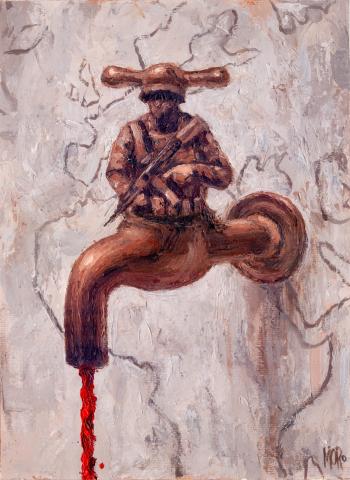
Derramamiento
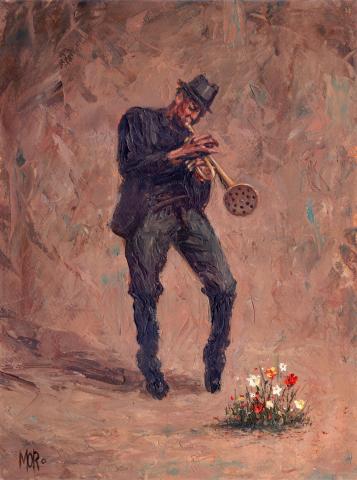
Music-water
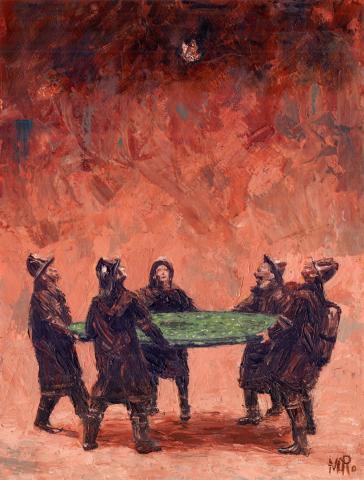
The Rescue
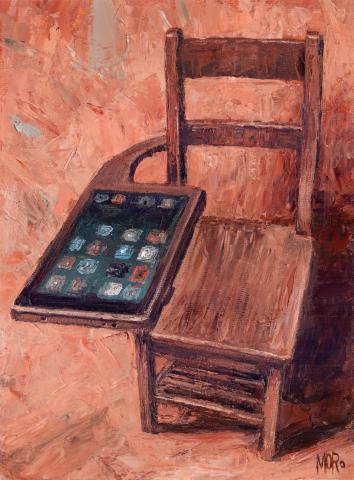
Digital education
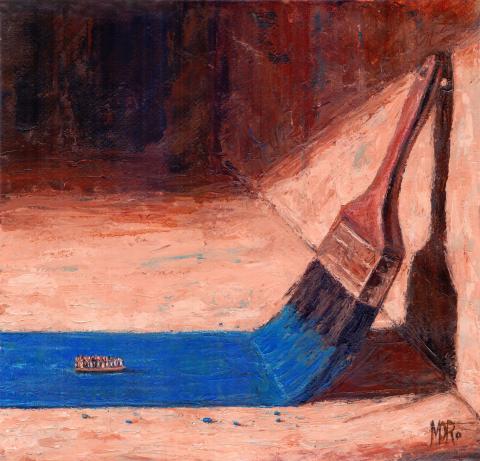
Delusions
Interview with Michel Moro
By Pepe Pelayo
When I was a teenager, I always heard the word “Moro” and identified it with someone similar to a half-Muslim mulatto. And it was not far from the truth, because a native of northern Africa on the border with Spain is called “Moor.” I even remember a popular song that said “There in Syria there is a Moorish woman, who has such beautiful eyes, like a charming star…”. I don't know if it was from the MataMoros trio.
But later, by feeding myself with readings, I met Thomas More (1478-1535), the jurist, philosopher, theologian, politician, writer and even saint and martyr of the Catholic Church. But as my level of information increased, I reached Aldo Moro, the famous Italian politician and intellectual, kidnapped and executed by the infamous Red Brigades.
And I thought it was not going to be easy to find another renowned “Moro.” Well I was wrong. One day a colleague tells me, “Pelayo, there is a Cuban cartoonist who is very good, he is publishing in the dedeté” and he signs his works as “Moro.” I looked it up and I loved his drawing. I followed him from afar until I dedicated myself more seriously to studying humor and saw that that Moro was already winning prizes in international competitions.
But I'm not getting ahead of myself. I will begin this biographical synthesis in an orderly manner:
Michel Moro Gómez (1988) was born in Ciego de Ávila, Cuba. From 2003 to 2007 he studied Painting and Drawing at the Raúl Corrales Academy of Fine Arts and from 2010 to 2016 he studied Conservation and Restoration at the University of the Arts of Havana. He has held countless individual and group exhibitions both in Cuba and abroad. He collaborates with his works in a few publications and has obtained many national and foreign awards and distinctions. For example, in Macedonia, Turkey, Korea, Mexico, etc., including Honorable Mention in the “World Press Cartoon”, Portugal and the “Eduardo Abela” Grand Prize, in the XXII International Biennial of Graphic Humor, two very prestigious awards .
And I will not delay any longer in starting this vis-à-vis with this countryman that I admire and who, without a doubt, is the funniest “Moor” of those I met.
PP: My friend, I don't know if I introduced you well, but why don't you introduce yourself? This way Humor Sapiens readers will know you however you want.
MORO: Your presentation was good, but I can still say that my name is Michel Moro Gómez, I am Cuban, I work and live in Cuba. I have been or intend to be a draftsman, caricaturist and painter for more than 10 years.
PP: How do you “pretend to be”? You are a great cartoonist! Do not be so modest. But before continuing, do you like being interviewed?
MORO: Generally yes, although it depends on who and where. Here and with you it is a pleasure.
PP: Thank you very much! I hope that after you see my questions you continue to feel pleasure. Well, start... How do you see humor in Cuba, whether on TV, radio, theater. literature or graphics?
MORO: The greatest health that humor can have in Cuba is all the talented people there are and who emerge in all areas. In the case of the graph it is the same. Despite the fact that nothing escapes the deep crisis that we are going through and that affects not only material matters, but also the will to do more. In the graph, the shows with greater or lesser attendance and diffusion have been maintained and new ones have also emerged. Editorial caricature has been in decline in the world in terms of spaces in the press, censorship and celebration of salons. This of course influences Cuba. Tradition and talent are great so I am optimistic.
PP: Without a doubt, you are right, for me there are many comedians, but you did not want to analyze humor in theater, TV, radio, literature, etc. But tell me, has your work evolved a lot since you started until now, both in form and content?
MORO: I think so, a lot and for the better in both senses. I think that in craft and technique it is remarkable, I have tried to incorporate a lot of plasticity and expressionism. There is also a notable evolution in concepts, they are less naive and there is more synthesis. All this has been a natural process from daily work.
PP: Good answer. Daily work is essential. Hey, which comedians do you identify with the most? Do you think that any of your predecessors or contemporaries influenced your work at the beginning?
MORO: I identify with Chago, Ares, Daumier, Magritte, Boligan, Kosobukin, there is no order but they are there. Since I started doing graphic humor, they influenced me and the conception I wanted to give to the ideas.
PP: They all belong to the cream of the crop of graphic humor for me too. One thing, do you like creating cartoons without text or with text better? Can you explain why?
MORO: I like not to use texts. It is a universal language, and a powerful image based on visual symbols always satisfies me and communicates more.
PP: I completely agree. And for you, are there limits to humor? (obligatory question in these times).
MORO: I think so, the limits are in doing it well. Any topic can be discussed but always with excellence, originality and ethics. There must always be the flavor that you communicate and move consciences.
PP: I'm not very sure, my friend. For example, for a guy who has a very different concept of ethics than you and me, he does his job well and perhaps harms society with his messages. And furthermore, even if you do your works with excellence, originality and ethics, perhaps an authority, someone with power will come and not publish you, or fanatical people will see your work and shred it. In short, it is a complex topic and hopefully one day, with more time, we will analyze it, through coffee or beer. And by the way, have you ever been censored? Do you censor yourself a lot?
MORO: Ever. I remember on one occasion, a few years ago, when a caricature of Pope Francis was censored. The decision-makers believed that the Pope should not be in the image at a higher height than the monument in the Plaza de la Revolución in Havana. Paradoxically, I censor myself less and perhaps that is why lately my work for publication has not been censored.
PP: Yes, it is a great paradox without a doubt. But your censored Pope reminded me of a time when my publisher took me to an Opus Dei school here in Chile, promoting my children's humor books as was customary, and I started. The presentation asking the children present to tell me jokes. And a little first-grade boy stood up and told a “curtain-raising” joke. In each of the three scenes a bomb fell on the Vatican. And at the end he tells me “what is the name of the work? Mashed potatoes!". Imagine the teachers' faces. I was going to punish him and I started to explain to them that this was not a mockery of the Pope, it was a simple play on words. Luckily they left him alone. But I told you because they almost always censor it or understand the message. Well, now it occurs to me to ask you: can you tell me a funny, curious or ingenious anecdote, related to your profession as a comedian?¿
MORO: On one occasion while I was in Spain as a result of my work in book illustration, I discovered that the editor with whom I work is a friend of Andrés Rabago (El Roto) and I asked him to arrange a meeting to meet him. In front of me he called him, but he so exaggerated my desire to meet him and my admiration for El Roto that El Roto told him, not with pleasure, that that was fetishism, haha. I only managed a telephone conversation. Then I received a book dedicated and autographed by him. He was actually very kind.
PP: “Don't defend me, compadre,” you would have told your editor. Moro, how do you see the state of graphic humor in the world today? Is the Internet the solution to the problem of the closure of magazines, newspapers, etc.?
MORO: I think there are good shows that demonstrate that graphic humor is an art that attracts the public and generates interest in promoting it not only in the media. Other salons that have ceased to exist due to insufficient will and funding show us that attention needs to be drawn. Censorship is also gaining ground, but there are very constant authors and other very good younger ones who emerge. The Internet is a powerful tool, but you have to know how to take advantage of it and whether it is part of the solution to promoting and publishing graphic humor. Although print media may be somewhat doomed and in decline, it is still part of the spaces.
PP: The matter is not easy, my friend. Hey, I also have to ask you this, for reasons of the book I'm writing: for you, is it easier to make people cry than to make them laugh?
MORO: I think generating emotions from artistic work is always difficult. I would rather say that it is better to move ideas with laughter, from humor.
PP: Would you like to do something within humor that you haven't done until now?
MORO: I would like to do more comics, maybe some animation and continue bringing satirical ideas and works to the canvas.
PP: I am sure you will achieve all those goals. And tell me, are there any questions I didn't ask you that you wish I had asked you? If so, can you answer it now?
MORO: No.
PP: Perfect. And to close, what would you say to those who like your work? Those who don't like it? To me as a comedian? And finally, what would you say to our Humor Sapiens readers?
MORO: To those who like my work I would say thank you; To those who don't, I'm sorry; I would say to you that humor is one of the best ways to communicate, and readers should continue with Humor Sapiens and graphic humor.
PP: I liked your answer, except for referring to you. Well, I thank you millions for having dedicated your time and attention to this vis-à-vis. I wish you good health, luck and continued success.
MORO: And many thanks to you Pepe. The conversation was a pleasure.
PP: And you continue with you! It looks like you are huMOROus!... And seriously, it was also a pleasure for me to share with you.
(This text has been translated into English by Google Translate)

